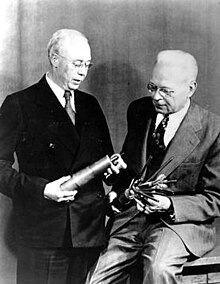
Bell Labs is an American industrial research and scientific development company. Researchers from there are credited with the development of radio astronomy, the transistor, the laser, the photovoltaic cell, the charge-coupled device (CCD), information theory, the Unix operating system, and the programming languages B, C, C++, S, SNOBOL, AWK, AMPL, and others. Ten Nobel Prizes and five Turing Awards have been awarded for work completed at Bell Laboratories.

Oliver Heaviside FRS was an English self-taught mathematician and physicist who invented a new technique for solving differential equations, independently developed vector calculus, and rewrote Maxwell's equations in the form commonly used today. He significantly shaped the way Maxwell's equations are understood and applied in the decades following Maxwell's death. His formulation of the telegrapher's equations became commercially important during his own lifetime, after their significance went unremarked for a long while, as few others were versed at the time in his novel methodology. Although at odds with the scientific establishment for most of his life, Heaviside changed the face of telecommunications, mathematics, and science.
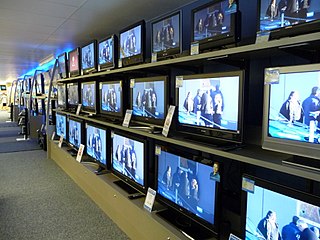
Television (TV) is a telecommunication medium for transmitting moving images and sound. Additionally, the term can refer to a physical television set, rather than the medium of transmission. Television is a mass medium for advertising, entertainment, news, and sports. The medium is capable of more than "radio broadcasting", which refers to an audio signal sent to radio receivers.

Coaxial cable, or coax, is a type of electrical cable consisting of an inner conductor surrounded by a concentric conducting shield, with the two separated by a dielectric ; many coaxial cables also have a protective outer sheath or jacket. The term coaxial refers to the inner conductor and the outer shield sharing a geometric axis.

Sidney Darlington was an American electrical engineer and inventor of a transistor configuration in 1953, the Darlington pair. He advanced the state of network theory, developing the insertion-loss synthesis approach, and invented chirp radar, bombsights, and gun and rocket guidance.

The telautograph is an ancestor of the modern fax machine. It transmits electrical signals representing the position of a pen or tracer at the sending station to repeating mechanisms attached to a pen at the receiving station, thus reproducing at the receiving station a drawing, writing, or signature made by the sender. It was the first such device to transmit drawings to a stationary sheet of paper; previous inventions in Europe had used a constantly moving strip of paper to make such transmissions and the pen could not be lifted between words. Surprisingly, at least from a modern perspective, some early telautographs used digital/pulse-based transmission while later more successful devices reverted to analog signaling.
The year 1929 in science and technology involved some significant events, listed below.
A single-wire transmission line is a method of transmitting electrical power or signals using only a single electrical conductor. This is in contrast to the usual use of a pair of wires providing a complete circuit, or an electrical cable likewise containing two conductors for that purpose.
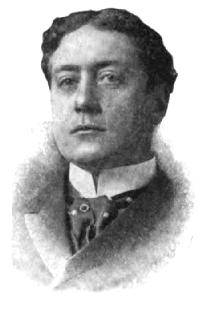
John Stone Stone was an American mathematician, physicist and inventor. He initially worked in telephone research, followed by influential work developing early radio technology, where he was especially known for improvements in tuning. Despite his often advanced designs, the Stone Telegraph and Telephone Company failed in 1908, and he spent the remainder of his career as an engineering consultant.
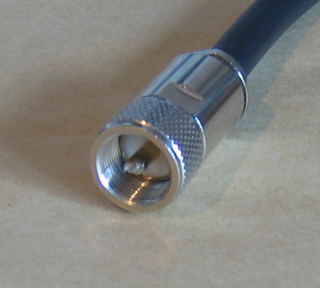
The UHF connector is a name for a threaded RF connector. The connector design was invented in the 1930s for use in the radio industry, and is a shielded form of the "banana plug". It is a widely used standard connector for HF transmission lines on full-sized radio equipment, with BNC connectors predominating for smaller, hand-held equipment.

The concept of television is the work of many individuals in the late 19th and early 20th centuries. The first practical transmissions of moving images over a radio system used mechanical rotating perforated disks to scan a scene into a time-varying signal that could be reconstructed at a receiver back into an approximation of the original image. Development of television was interrupted by the Second World War. After the end of the war, all-electronic methods of scanning and displaying images became standard. Several different standards for addition of color to transmitted images were developed with different regions using technically incompatible signal standards. Television broadcasting expanded rapidly after World War II, becoming an important mass medium for advertising, propaganda, and entertainment.

A radar altimeter (RA), also called a radio altimeter (RALT), electronic altimeter, reflection altimeter, or low-range radio altimeter (LRRA), measures altitude above the terrain presently beneath an aircraft or spacecraft by timing how long it takes a beam of radio waves to travel to ground, reflect, and return to the craft. This type of altimeter provides the distance between the antenna and the ground directly below it, in contrast to a barometric altimeter which provides the distance above a defined vertical datum, usually mean sea level.

Harold Henry "Bev" Beverage was an American inventor and researcher in electrical engineering. He is known for his invention and development of the wave antenna, which came to be known as the Beverage antenna. Less widely known is that Bev was a pioneer of radio engineering and his engineering research paralleled the development of radio transmission technology throughout his professional career with significant contributions not only in the field of radio frequency antennas but also radio frequency propagation and systems engineering.

Edith Clarke was an American electrical engineer. She was the first woman to be professionally employed as an electrical engineer in the United States, and the first female professor of electrical engineering in the country. She was the first woman to deliver a paper at the American Institute of Electrical Engineers; the first female engineer whose professional standing was recognized by Tau Beta Pi, the oldest engineering honor society and the second oldest collegiate honor society in the United States; and the first woman named as a Fellow of the American Institute of Electrical Engineers. She specialized in electrical power system analysis and wrote Circuit Analysis of A-C Power Systems.
The L-carrier system was one of a series of carrier systems developed by AT&T for high-capacity transmission for long-distance communications. Over a period from the late 1930s to the 1970s, the system evolved in six significant phases of development, designated by Bell System engineers as L-1 through L-5, and L-5E. Coaxial cable was the principal transmission medium in all stages, initially lending the system another description i.e. the coaxial system. It was the successor to a series of previous carrier systems, typically identified by capital letters. In the 1960s, the system was hardened against the dangers of the Cold War using complete placement of all terminal and repeater equipment in hardened underground vaults.
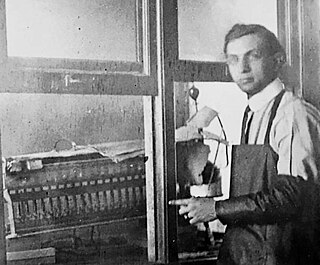
Otto Julius Zobel was an electrical engineer who worked for the American Telephone & Telegraph Company (AT&T) in the early part of the 20th century. Zobel's work on filter design was revolutionary and led, in conjunction with the work of John R. Carson, to significant commercial advances for AT&T in the field of frequency-division multiplex (FDM) telephone transmissions.
James R. Wait was a Canadian electrical engineer and engineering physicist. In 1977, he was elected as a member of National Academy of Engineering in Electronics, Communication & Information Systems Engineering for his contributions to electromagnetic propagation engineering as it affects communication and geophysical exploration.

George Ashley Campbell was an American engineer. He was a pioneer in developing and applying quantitative mathematical methods to the problems of long-distance telegraphy and telephony. His most important contributions were to the theory and implementation of the use of loading coils and the first wave filters designed to what was to become known as the image method. Both these areas of work resulted in important economic advantages for the American Telephone and Telegraph Company (AT&T).
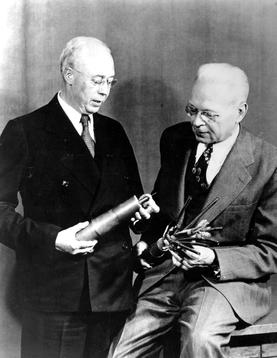
Lloyd Espenschied was an American electrical engineer who invented the modern coaxial cable with Herman Andrew Affel.
Carlos Katz is an American electrical engineer, researcher and the recipient of the 2010 IEEE award. His area of research is the properties and methods of manufacture of extruded and laminar dielectric high voltage power cables, and extension of service life of installed cables. He has written papers about the effects of water treeing on the life of cable installations.
